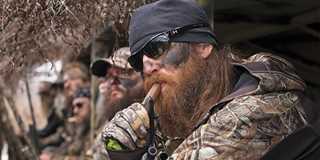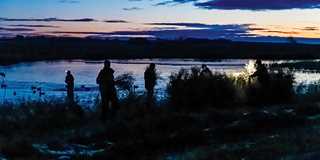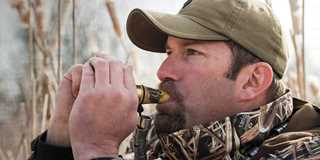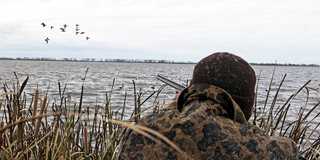Finishing Late-Season Waterfowl
Expert waterfowlers offer valuable lessons on how to fool decoy-shy ducks and geese
Expert waterfowlers offer valuable lessons on how to fool decoy-shy ducks and geese

by Will Brantley
Few sights are more mesmerizing to a waterfowler than a flock of ducks or geese on final approach with their wings cupped and feet down. When that happens, it means we've done everything right-we've set the perfect decoy spread, called at just the right times, and concealed ourselves so effectively that our quarry is completely unaware of our presence. Consistently finishing waterfowl requires patience and no small amount of skill, especially late in the season, when waterfowl have seen and heard it all. The following five expert waterfowlers could teach a class on fooling wary late-season waterfowl, and they've agreed to share some of their secrets with us. Finishing school is now in session.

Jase Robertson
Chief Operating Officer, Duck Commander Calls

Photo © RICKADAIR.COM
Few people are better known in the waterfowling world than Jase Robertson. Onscreen antics aside, the Duck Commander crew has long been recognized for their ability to capture high-quality waterfowl hunting video footage, and to do that, you have to be skilled at getting ducks in close. Robertson may be running a duck call company, but he believes that effective concealment, above everything else, is the key to getting ducks to finish over a decoy spread. "Before you even think about calling, you have to eliminate other potential problems, and I always start with putting lots of brush on my blind," Robertson says. "If ducks consistently will not finish, regardless of your calling or decoys, it's usually because they're seeing you."
Of course, Robertson believes in calling, too, but it has to sound like the real thing. "I don't like to do anything a duck won't do," he says. "But that doesn't mean being silent, either."
In the end, Robertson believes that the simple single quack will finish more ducks than any other sound. "It's not a rapid quack-that can sound like an alarm call-but just a content, lonely quack," he explains. "Hen mallards make that sound all the time. When ducks are working, we'll keep calling all the way to the water. When you quit at the last minute, the birds start looking, and that's when they'll spot you."

Photo © RICKADAIR.COM
Fred Zink
President, Zink Calls

Photo © JIM THOMPSON
World champion goose caller Fred Zink is one of the nation's most experienced and innovative waterfowlers, and he has a reputation for being a perfectionist when it comes to how he hunts. Zink is meticulous about his decoy spread and blind setup, whether he's hunting early-season specklebellies on the Canadian prairie or late-season honkers back home in Ohio. He says one of the surest ways to spook an incoming flock of geese is to have something amiss in the spread. Overturned decoys, empty shell boxes, harvested birds lying belly up, and unusual shadows are some of the biggest giveaways.
"When the action is fast and furious and you have a blind full of hunters, and geese are in the air, it can be tempting to forget about your decoys until there is a lull in the action. But that's a big mistake," Zink says. "Time and again, I've seen flocks of geese flare at 50 yards because of a single decoy lying on its side in a spread of six dozen decoys."
Like many field hunters, Zink is a big fan of portable A-frame blinds. These blinds are quick to set up and, for many hunters, easier to shoot from than layout blinds. When they're properly brushed up, they provide deadly concealment too. But these blinds can cast long shadows when the sun comes up, particularly when they're placed in an open field.
"Working geese can see that shadow from above," Zink says. "If birds finish early in the morning but become wary as the sun rises, have a good look at your blind. If it's throwing a large shadow in the spread, you can often just pick up the blind and move it to a spot where the shadow isn't as visible. I can't tell you how many times that has made the difference in getting birds to finish on sunny days."

Buck Gardner
Founder, Buck Gardner Calls

Photo © TRAVIS MUELLER/BANDED OUTDOORS
When hunting wary late-season waterfowl, it's important to make the most of your opportunities, even if it means putting only one bird in the bag.
Legendary call maker and world champion duck caller Buck Gardner says an important lesson that he has learned over the years is to take advantage of ducks when they do finish and to avoid the temptation to pass up a good opportunity for a chance at a better one. "How many times have you been working a big bunch of ducks when one or two birds drop into the decoys? If you decide not to shoot those birds, you might end up with nothing in the bag. It's happened to me-and most other hunters I know-more than once," Gardner says with a chuckle.
For that reason, Gardner doesn't believe in having a "blind boss" who calls the shot for everyone. "So many times, when guys are working ducks, ego gets in the way. We've got an easy shot at two mallards right in front of us, but there are 10 or 12 more circling, and we want those too. Next thing you know, they're all gone without a shot being fired," he says. "I've learned over the years to shoot when you have the chance. Of course, that doesn't mean to sky bust and shoot at ducks that are too far away. And I stress safety over everything else. But when you're talking about truly finishing ducks, even on good hunts, you might get only five or six opportunities. Be in sync with your hunting partners, and don't waste chances when you get them."

Blake McWilliams
West Tennessee outfitter and guide
Blake McWilliams and his team of guides stay booked for most of the 60-day Tennessee duck season. Many of their blinds border Hatchie National Wildlife Refuge, which is managed for waterfowl and routinely winters tens of thousands of ducks. This provides ample opportunities to decoy birds, but these birds also receive a tremendous amount of hunting pressure. That's why it's important to use the most realistic decoys available, even when there are plenty of ducks in the area.
"Good-looking decoys and motion are so important today," McWilliams says. "We use a variety of motion decoys, set on timers, to keep a constant ripple on the water. It's a little more expensive and time consuming, but with so many duck hunters out there now, you get back what you put into your spread."
Despite using several dozen decoys at a time, McWilliams usually picks them up after each hunt. He also rests his fields to give ducks a chance to feed without being disturbed. "If there is anything we can do to improve our chances of success, we'll do it," he says.
Like Robertson and Zink, McWilliams is a stickler for concealment. In most cases, he avoids building blinds in open areas. "From Canada all the way down the flyways, ducks see brush-covered boxes in the middle of fields with a hundred decoys sitting around them. It's a red flag," he says.
McWilliams and his guides build most of their blinds in tree lines on field edges. They routinely add fresh brush and other vegetation to their blinds throughout the season to keep them concealed. "The usual oak brush works, but my favorite blind camouflage is honeysuckle. We cut it in August and September with hedge trimmers, and then roll it up into bundles," he says. "It's a hassle to fasten to blinds, but once it's on there, you're hidden like a mouse in a rug."

Wayne Radcliffe
Territory Manager, Banded/Avery Outdoors

Photo © JEFF MOORE
Diving ducks will often decoy at close range if you are patient.
Wayne Radcliffe has been hunting bluebills, canvasbacks, and redheads off Maryland's Eastern Shore since the late 1980s. He's learned a lot about gunning divers in this storied area, including a few decoy tricks to get these notoriously fast fliers into easy range. "A lot of people will see a group of divers buzz along the fringes of the spread and start shooting, thinking that's the best chance they'll get," Radcliffe says. "But bluebills and especially canvasbacks will often give a spread an initial look, circle around into the wind, and then rain right into the decoys. I've seen cans circle two or three times. The point is, don't get impatient when you see a flock of divers coming. Many times, if you'll just let them work, they'll give you an easy shot."
Radcliffe says scaup and canvasbacks will follow lines of decoys, but they often won't set their wings to commit until they reach the head of a spread. For that reason, many veteran diver hunters set lines of decoys on the edge of the spread that lead ducks back to a cluster of decoys near the shooters' boat or blind.
"I used to hunt with a guy who would take single bluebill decoys out in the boat with him," Radcliffe recalls. "He'd drop one 50 yards past the farthest decoy on his outside line. Then he'd go 50 more yards and drop another decoy, and then drop another one 50 yards past that. By the time it was said and done, he'd have a loose line of bluebill decoys extending a couple of hundred yards beyond his primary spread. Bluebills that were flying way out and would've otherwise never looked at our rig would pick up that line and follow it right toward us. Once they'd see the main decoy rig, we'd usually get easy shooting."
Radcliffe's final tip is to be species specific when setting your decoy spread. Most diving ducks will decoy best to their own kind. "Last year, we had a phenomenal season for bluebills and cans, and we'd often shoot our two-bird limits early, and then get to watch numerous ducks decoy throughout the day," he says. "Almost without exception, the canvasbacks would sit right next to the canvasback decoys, and the bluebills would go right to the bluebill decoys. They can pick out those details better than many hunters realize."
Ducks Unlimited uses cookies to enhance your browsing experience, optimize site functionality, analyze traffic, and deliver personalized advertising through third parties. By continuing to use this site, you agree to our use of cookies. View Privacy Policy